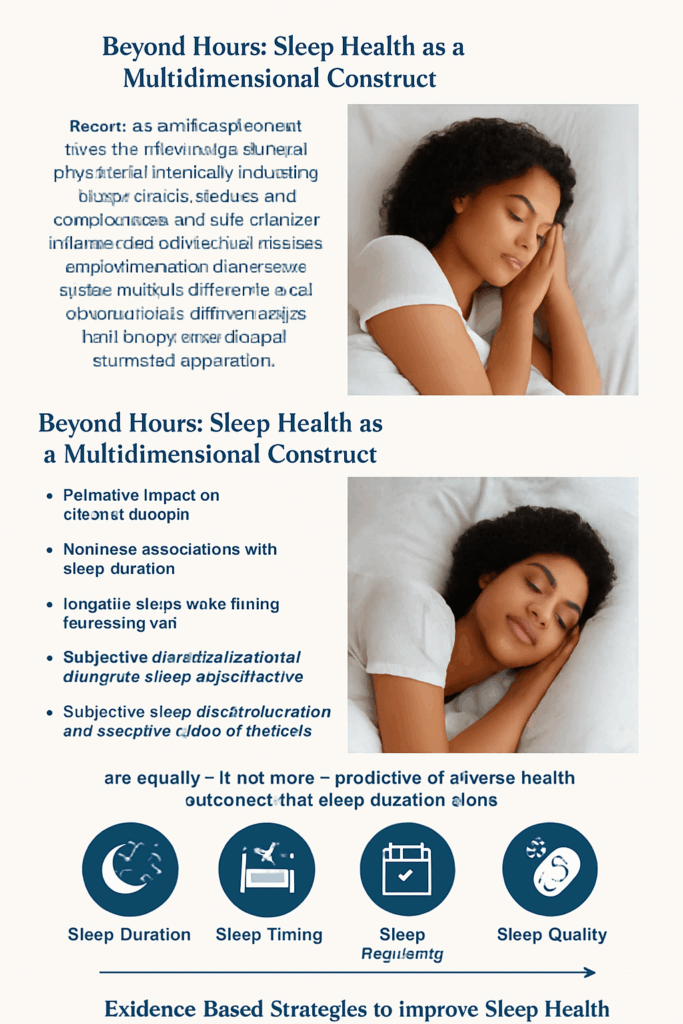
Sleep functions as a central regulator of human physiology, profoundly influencing cardiovascular function, metabolic homeostasis, immune competence, and overall longevity. Despite its biological significance, public discourse on sleep health often remains narrowly focused on total duration. However, emerging evidence emphasizes that sleep is a complex, multidimensional construct encompassing not only quantity, but also timing, regularity, quality, and circadian alignment — all of which contribute synergistically to systemic health.
A recent scientific statement from the American Heart Association, published in Circulation: Cardiovascular Quality and Outcomes, underscores this paradigm shift. The statement synthesizes current evidence demonstrating that disturbances across multiple dimensions of sleep can substantially elevate the risk of chronic disease — frequently before the onset of overt clinical symptoms.
Beyond Hours: Sleep Health as a Multidimensional Construct
Historically, epidemiological investigations have primarily examined sleep duration in relation to disease outcomes. In contrast, this new statement evaluates sleep using a multidimensional framework. Parameters such as sleep duration, timing, consistency, subjective satisfaction, sleep architecture (i.e., stages of sleep), and daytime alertness were integrated to assess overall sleep health.
Key Findings from the Statement:
- Pervasive impact on chronic disease: Sleep disturbances are widespread across populations, but disproportionately affect low-income and minority groups. These disparities are associated with increased prevalence of obesity, insulin resistance, hypertension, cardiovascular disease, and subclinical cerebrovascular pathology.
- Nonlinear associations with sleep duration: Both short (<7 hours) and long (>9 hours) sleep durations were correlated with elevated cardiometabolic risk, including obesity, type 2 diabetes, and cardiovascular disease.
- Irregular sleep-wake timing increases risk: Variability in bed and wake times was linked to elevated blood pressure, glucose dysregulation, and a nearly twofold increase in cardiovascular disease risk relative to consistent sleep schedules.
- Daytime sleepiness as a clinical indicator: Self-reported daytime drowsiness — irrespective of total sleep time — was associated with increased incidence of stroke, myocardial infarction, and metabolic dysfunction.
- Subjective sleep dissatisfaction and disrupted sleep architecture: Individuals who perceived their sleep as inadequate or non-restorative, or who experienced disruptions in key sleep stages (such as slow-wave and REM sleep), exhibited adverse biomarker profiles, including elevated inflammatory markers, endothelial dysfunction, and impaired glucose regulation.
Sleep Restoration Yields Rapid Physiological Benefits
The evidence further suggests that improvements in sleep regularity and quality can produce measurable benefits in a relatively short time frame. Even brief periods of irregular or poor-quality sleep (e.g., several weeks) were sufficient to induce elevations in blood pressure, fasting glucose, and vascular inflammation.
Highlights of Rapid Recovery Potential:
- Quick reversal of dysfunction: Individuals who adopted more consistent sleep patterns, improved subjective sleep quality, or reduced nocturnal awakenings exhibited improvements in cardiometabolic markers within weeks.
- High responsiveness in at-risk individuals: Those with the poorest baseline sleep parameters demonstrated the most significant improvements in blood pressure, insulin sensitivity, and daytime alertness following sleep optimization.
Timing and Quality Are as Critical as Duration
Importantly, the statement concluded that sleep timing, regularity, and satisfaction were equally — if not more — predictive of adverse health outcomes than sleep duration alone.
- Consistency is key: Regular sleep and wake times were among the strongest predictors of positive cardiometabolic health outcomes.
- Subjective sleep quality and continuity matter: Restorative sleep, characterized by uninterrupted cycles and high subjective satisfaction, was strongly associated with favorable cardiovascular and metabolic profiles, even when total duration fell within conventional “healthy” ranges.
Underlying Mechanisms: Biological Pathways Linking Sleep to Disease
Multiple physiological mechanisms were proposed to explain the causal links between poor sleep and chronic disease:
- Circadian misalignment: Irregular sleep patterns disrupt circadian rhythms, impairing hormonal signaling (e.g., cortisol, melatonin) and interfering with blood pressure regulation, endothelial repair, and glycemic control.
- Chronic low-grade inflammation: Sleep deprivation and fragmentation promote systemic inflammation, contributing to atherosclerosis, vascular injury, and insulin resistance.
- Loss of restorative sleep stages: Deprivation of slow-wave sleep impairs cardiovascular recovery and metabolic regulation, facilitating cumulative biological damage over time.
These findings reinforce the role of sleep as a dynamic biological system whose integrity is essential to health maintenance and disease prevention.
Evidence-Based Strategies to Improve Sleep Health
To optimize cardiometabolic health through improved sleep, the following evidence-based behavioral interventions are recommended:
- Optimize darkness during sleep: Eliminate sources of light in the sleep environment (e.g., screens, electronics, ambient light) to enhance nocturnal melatonin secretion. Use blackout curtains and remove electronic devices to support circadian alignment.
- Expose yourself to natural light upon waking: Exposure to outdoor light within 15–30 minutes of waking strengthens circadian entrainment and enhances mood, alertness, and hormonal balance. This can be achieved through brief outdoor activity without sunglasses or window filters.
- Minimize blue light exposure after dusk: Blue light emitted by digital screens suppresses melatonin production and elevates cortisol levels. Avoid screens after sunset or use blue-light-blocking interventions (e.g., amber glasses or night mode settings).
- Maintain a cool sleep environment: A nighttime room temperature of 60–68°F (15.5–20°C) facilitates thermoregulation necessary for deep sleep. Use breathable bedding and avoid overheating to maintain sleep continuity.
- Limit exposure to electromagnetic fields (EMFs): Although the evidence remains mixed, preliminary research suggests EMFs from Wi-Fi and electronic devices may disrupt sleep quality. Minimizing EMF exposure by powering down devices and removing electronics from the bedroom may promote deeper rest.
Conclusion
Sleep is not merely a passive state of rest but a highly regulated physiological process critical to cardiometabolic health. Modern sleep science highlights the importance of a multidimensional approach — encompassing duration, regularity, quality, and circadian alignment — to mitigate chronic disease risk and support long-term vitality. Simple, low-cost behavioral modifications can yield rapid and clinically meaningful benefits, making sleep optimization a cornerstone of preventive health.
